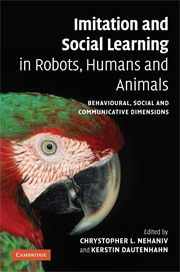Crossref Citations
This Book has been
cited by the following publications. This list is generated based on data provided by Crossref.
Kotake, Masato
Katagami, Daisuke
and
Nitta, Katsumi
2007.
Acquisition of Behavioral Patterns Depends on Self-Embodiment Based on Robot Learning Under Multiple Instructors.
Journal of Advanced Computational Intelligence and Intelligent Informatics,
Vol. 11,
Issue. 8,
p.
989.
Acerbi, Alberto
Marocco, Davide
and
Vogt, Paul
2008.
Social learning in embodied agents.
Connection Science,
Vol. 20,
Issue. 2-3,
p.
69.
Demiris, Yiannis
and
Meltzoff, Andrew
2008.
The robot in the crib: a developmental analysis of imitation skills in infants and robots.
Infant and Child Development,
Vol. 17,
Issue. 1,
p.
43.
Montes de Oca, Marco A.
and
Stützle, Thomas
2008.
Towards incremental social learning in optimization and multiagent systems.
p.
1939.
Pini, Giovanni
and
Tuci, Elio
2008.
On the design of neuro-controllers for individual and social learning behaviour in autonomous robots: an evolutionary approach.
Connection Science,
Vol. 20,
Issue. 2-3,
p.
211.
Moghaddam, Fathali M.
2009.
Commentary: Omniculturalism: Policy Solutions to Fundamentalism in the Era of Fractured Globalization.
Culture & Psychology,
Vol. 15,
Issue. 3,
p.
337.
Acerbi, A.
and
Marocco, D.
2009.
Orienting learning by exploiting sociality: An evolutionary robotics simulation.
p.
20.
Dautenhahn, Kerstin
Nehaniv, Chrystopher L.
Walters, Michael L.
Robins, Ben
Kose-Bagci, Hatice
Mirza, N. Assif
and
Blow, Mike
2009.
KASPAR – A Minimally Expressive Humanoid Robot for Human–Robot Interaction Research.
Applied Bionics and Biomechanics,
Vol. 6,
Issue. 3-4,
p.
369.
Boccanfuso, Laura
and
O’Kane, Jason M.
2011.
CHARLIE : An Adaptive Robot Design with Hand and Face Tracking for Use in Autism Therapy.
International Journal of Social Robotics,
Vol. 3,
Issue. 4,
p.
337.
Nguyen, Sao Mai
Baranes, Adrien
and
Oudeyer, Pierre-Yves
2011.
Bootstrapping intrinsically motivated learning with human demonstration.
p.
1.
Nguyen, Sao Mai
and
Oudeyer, Pierre-Yves
2012.
Properties for efficient demonstrations to a socially guided intrinsically motivated learner.
p.
614.
Salah, Albert Ali
Ruiz-del-Solar, Javier
Meriçli, Çetin
and
Oudeyer, Pierre-Yves
2012.
Human Behavior Understanding.
Vol. 7559,
Issue. ,
p.
1.
Nguyen, Sao Mai
and
Oudeyer, Pierre-Yves
2012.
Active Choice of Teachers, Learning Strategies and Goals for a Socially Guided Intrinsic Motivation Learner.
Paladyn, Journal of Behavioral Robotics,
Vol. 3,
Issue. 3,
p.
136.
Nguyen, Sao Mai
and
Oudeyer, Pierre-Yves
2012.
Interactive learning gives the tempo to an intrinsically motivated robot learner.
p.
645.
2013.
Handbook of Collective Robotics.
p.
797.
Nguyen, Sao Mai
Ivaldi, Serena
Lyubova, Natalia
Droniou, Alain
Gerardeaux-Viret, Damien
Filliat, David
Padois, Vincent
Sigaud, Olivier
and
Oudeyer, Pierre-Yves
2013.
Learning to recognize objects through curiosity-driven manipulation with the iCub humanoid robot.
p.
1.
Moore, Roger K.
2013.
Your Virtual Butler.
Vol. 7407,
Issue. ,
p.
119.
Kormushev, Petar
Calinon, Sylvain
and
Caldwell, Darwin
2013.
Reinforcement Learning in Robotics: Applications and Real-World Challenges.
Robotics,
Vol. 2,
Issue. 3,
p.
122.
Ehrlich, Stefan
Wykowska, Agnieszka
Ramirez-Amaro, Karinne
and
Cheng, Gordon
2014.
When to engage in interaction — And how? EEG-based enhancement of robot's ability to sense social signals in HRI.
p.
1104.
2014.
Future Robots.
Vol. 7,
Issue. ,



